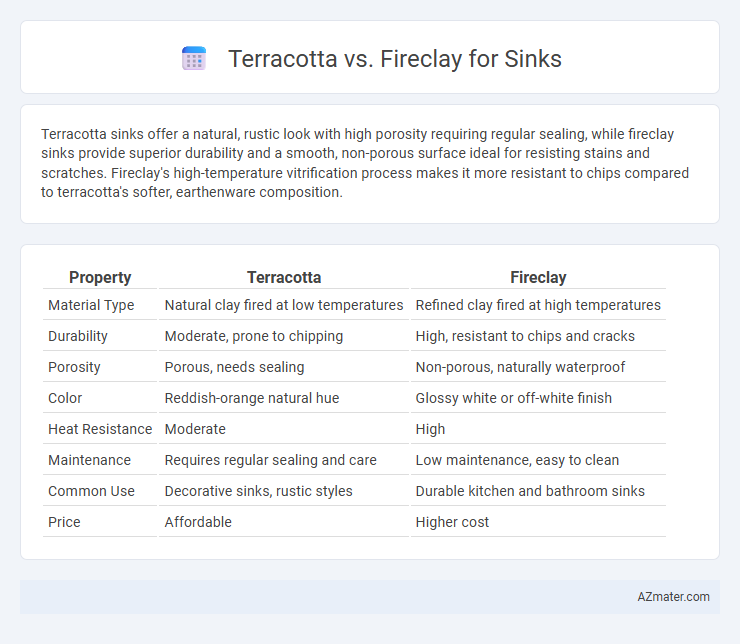Terracotta sinks offer a natural, rustic look with high porosity requiring regular sealing, while fireclay sinks provide superior durability and a smooth, non-porous surface ideal for resisting stains and scratches. Fireclay's high-temperature vitrification process makes it more resistant to chips compared to terracotta's softer, earthenware composition.
Table of Comparison
| Property | Terracotta | Fireclay |
|---|---|---|
| Material Type | Natural clay fired at low temperatures | Refined clay fired at high temperatures |
| Durability | Moderate, prone to chipping | High, resistant to chips and cracks |
| Porosity | Porous, needs sealing | Non-porous, naturally waterproof |
| Color | Reddish-orange natural hue | Glossy white or off-white finish |
| Heat Resistance | Moderate | High |
| Maintenance | Requires regular sealing and care | Low maintenance, easy to clean |
| Common Use | Decorative sinks, rustic styles | Durable kitchen and bathroom sinks |
| Price | Affordable | Higher cost |
Introduction to Terracotta and Fireclay Sinks
Terracotta sinks are crafted from natural clay fired at lower temperatures, resulting in a porous and rustic finish that requires regular sealing to prevent stains and moisture damage. Fireclay sinks, made by molding and firing clay at extremely high temperatures, offer a non-porous, durable surface resistant to chipping and scratches, making them ideal for heavy kitchen use. Both materials bring unique aesthetic qualities and functional benefits, with terracotta leaning towards a warm, earthy appeal and fireclay providing a glossy, contemporary look.
Material Composition and Manufacturing Process
Terracotta sinks are crafted from natural clay fired at lower temperatures, resulting in a porous and earthy material that requires glazing for water resistance. Fireclay sinks undergo firing at much higher temperatures, causing the clay to vitrify into a dense, non-porous ceramic with superior durability and resistance to chips and stains. The manufacturing process of fireclay involves molding refined clay mixed with minerals and firing it up to around 1300degC, whereas terracotta is typically fired between 1000degC and 1150degC, impacting the final strength and finish of each sink type.
Durability and Longevity Comparison
Fireclay sinks offer superior durability compared to terracotta due to their higher density and resistance to chipping, scratching, and heat exposure. Terracotta sinks, while aesthetically appealing, are more porous and prone to cracking or staining over time. Fireclay's vitrified surface enhances longevity, making it a more reliable choice for heavy-use kitchen environments.
Aesthetic Appeal and Design Options
Terracotta sinks offer a warm, rustic aesthetic with rich, earthy tones that enhance farmhouse and Mediterranean-style kitchens, while fireclay sinks provide a sleek, glossy finish ideal for modern and traditional settings. Terracotta's natural variations and hand-crafted texture deliver unique character, contrasted by fireclay's smooth surface and wide range of colors and shapes for versatile design integration. The choice between terracotta and fireclay significantly impacts the visual focal point of a kitchen, balancing between rustic charm and polished elegance.
Resistance to Stains and Scratches
Terracotta sinks, made from porous clay, tend to absorb stains more easily and are susceptible to scratches due to their softer surface. Fireclay sinks offer superior resistance to both stains and scratches, thanks to their dense, vitrified ceramic composition that is glazed and fired at extremely high temperatures. This durability makes fireclay especially suitable for heavy kitchen use where stain and scratch resistance are crucial.
Maintenance and Cleaning Requirements
Terracotta sinks require regular sealing to prevent staining and water absorption, as their porous nature makes them more susceptible to dirt and grime buildup. Fireclay sinks offer superior resistance to stains and scratches, making them easier to clean with just mild soap and water without the need for frequent sealing. Choosing fireclay reduces the maintenance time and effort compared to terracotta, which demands more diligent care to maintain its appearance and durability.
Cost and Budget Considerations
Terracotta sinks generally offer a more budget-friendly option compared to fireclay sinks, costing significantly less due to their simpler manufacturing process and material composition. Fireclay sinks, made from refined clay and fired at higher temperatures, tend to be more expensive but provide superior durability and resistance to chips and stains. Homeowners prioritizing cost-effectiveness often choose terracotta, while those seeking long-term investment and enhanced aesthetics typically prefer the premium pricing of fireclay sinks.
Installation Differences and Requirements
Terracotta sinks are generally lighter and easier to install, requiring standard plumbing connections and support due to their porous nature and need for proper sealing. Fireclay sinks, made from molded ceramic fired at high temperatures, are heavier and demand reinforced cabinetry or countertops for secure installation, along with specialized sealing techniques to prevent chipping and cracking. Both materials require careful handling, but fireclay's density and brittleness necessitate professional installation to avoid damage and ensure long-term durability.
Sustainability and Environmental Impact
Terracotta sinks, made from natural clay fired at lower temperatures, consume less energy during production but may be less durable and prone to chipping, impacting their long-term sustainability. Fireclay sinks, fired at higher temperatures around 1200degC, offer greater durability and resistance to scratches and stains, reducing the need for frequent replacements and contributing to lower environmental waste. Choosing fireclay sinks supports sustainability through longevity and efficient resource use, while terracotta provides an eco-friendly option with its biodegradable material and energy-efficient manufacturing process.
Choosing the Right Sink: Terracotta or Fireclay?
Terracotta sinks offer a warm, rustic aesthetic with excellent natural water resistance but require regular sealing to prevent staining and chipping. Fireclay sinks provide superior durability and a smooth, glossy finish that resists scratches, heat, and acidic substances, making them ideal for heavy kitchen use. Choosing between terracotta and fireclay depends on balancing style preferences with maintenance needs and durability requirements for your specific kitchen environment.

Infographic: Terracotta vs Fireclay for Sink
 azmater.com
azmater.com